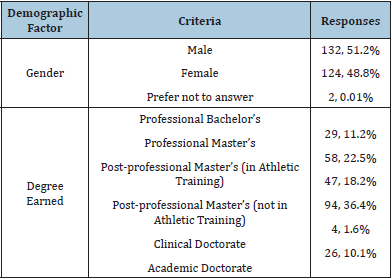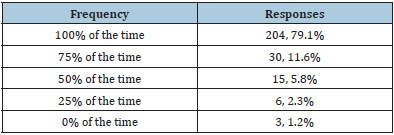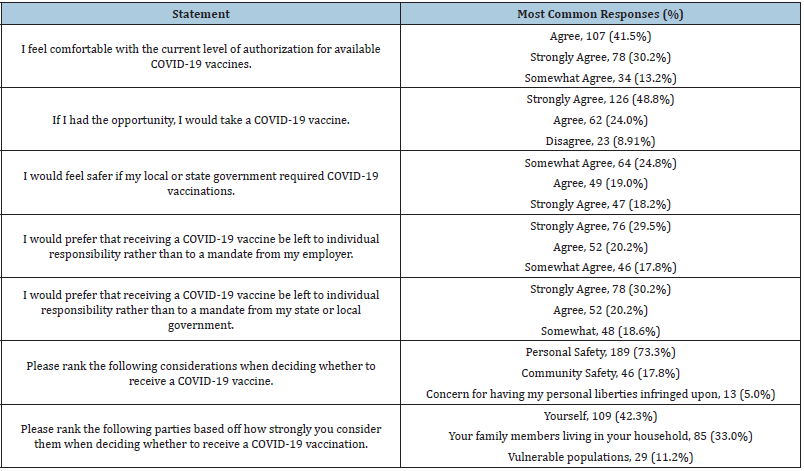- Submissions

Full Text
Research & Investigations in Sports Medicine
Attitudes Toward COVID-19 Vaccination Among Athletic Trainers in Early 2021
Cage SA1,2*, Warner BJ2,3, Ballard B1, Gallegos DM4, Goza JP5 and Warner LK6
1University of Texas at Tyler, USA
2University of North Carolina, USA
3Grand Canyon University, USA
4University of Texas Health East Texas, USA
5Collin College, USA
6AlphaMeD, USA
*Corresponding author: Cage SA, University of Texas at Tyler, USA
Submission: September 08, 2021;Published: October 20, 2021

ISSN: 2577-1914 Volume8 Issue1
Abstract
Following the widespread transmission of the novel coronavirus responsible for COVID-19, the first COVID-19 vaccine received emergency use authorization in December 2020. The purpose of this study is to describe the attitudes toward available COVID-19 vaccines among athletic trainers. 258 certified athletic trainers (age=43±12 years; years of certified experience=19±12 years) completed an electronic survey via email that collected data on demographics, face mask usage, and attitudes toward available COVID-19 vaccines. Data were downloaded and analyzed using a commercially available statistics package (SPSS Statistics Version 26, IBM, Armonk, NY). Measures of central tendency (means, standard deviations, frequencies) were calculated for all survey items. The majority of respondents reported that they were comfortable with the current level of authorization for available COVID-19 vaccines. Most athletic trainers stated that they would receive a COVID-19 vaccination when it was available, but that they would rather it be a voluntary choice rather than mandated by an employer or government body. The majority of athletic trainers reported personal, household, and vulnerable population safety as the primary considerations for receiving a COVID-19 vaccination. In general, these factors were more important to participants than were public perception or concerns over infringements of personal liberties. Given that athletic trainers continue to work in day-to-day patient care, it is important to consider the best means of educating athletic trainers on the potential benefits of COVID-19 vaccinations.
Introduction
Coronavirus disease 2019 (COVID-19) is a highly infectious respiratory disease caused by
severe acute respiratory syndrome coronavirus 2 (SARS-CoV-2). COVID-19 was first reported
in late 2019 in Wuhan, China [1]. Symptoms include fever, cough, fatigue, loss of smell, loss
of taste, body aches, shortness of breath, nausea, vomiting, and diarrhea [1]. In severe cases,
patients have experienced potentially fatal pneumonia, septic shock, metabolic acidosis, and
coagulation dysfunction [2]. Efforts during the first several months of the COVID-19 pandemic
focused on mitigating its spread, including testing, contact tracing, enhanced hygiene efforts,
use of face coverings, and social distancing [3-6]. In December 2020, the first vaccine against
COVID-19 received Emergency Use Authorization (EUA) from the United States Food and Drug
Administration [7].
As the global COVID-19 pandemic progressed, many communities and organizations
enacted legislation and rulings aimed at limiting the transmission of COVID-19. The National
Collegiate Athletic Association (NCAA) opted to cancel all remaining championships for the
2020 spring semester [8]. The majority of institutions and athletic conferences followed suit
and cancelled the remainder of their seasons [9], including many secondary schools, who
postponed or suspended athletic activities and face-to-face instruction [10,11]. Subsequently,
a study reported that many athletic trainers were suffering from increased levels of depression
and anxiety [12]. These findings suggested that some athletic trainers experienced adverse mental health effects as a result of the pandemic while participating
in their role as frontline healthcare workers. Further research is
underway to evaluate the epidemiology, diagnosis, treatment, and
prevention of COVID-19 [1-4]. To date, no publications appear to
be available on attitudes toward recently authorized COVID-19
vaccines. Therefore, the purpose of this study is to describe the
attitudes of athletic trainers toward COVID-19 vaccination.
Methods
Design
This cross-sectional study collected data by internet-based survey as approved by the University of Texas at Tyler IRB.
Participants
Participants were recruited by emailing the head athletic trainers at NCAA Division I, Division II, and Division III institutions, Commission on Accreditation of Athletic Training Education (CAATE) accredited program directors, and members of various regional and local athletic training organizations using publicly available databases. Recruiting was completed using the snowball technique; participants were asked to forward the study invitation to certified colleagues. A total of 258 certified athletic trainers completed the study (age = 43±12 years; years of certified experience = 19±12 years). Participant demographics are listed in Table 1.
Table 1: Participant demographic information.

Data collection
An email was sent in January 2021 to all prospective participants inviting them to participate in a survey accessible via hyperlink to a web-based server (Qualtrics Inc., Provo, UT). The email contained information about the investigators, the purpose of the study, and the nature of the survey. A follow-up email was sent two weeks after the initial email, and the survey was closed a week later prior to statistical analysis.
Instrument
Following the questions on informed consent and demographics, the survey posed questions about the professional settings in which respondents practice and whether they had returned to in-person work following a COVID-19-related stay-at-home order. Participants were also asked about opportunities they had had to receive a COVID-19 vaccine and about their current vaccination status. The survey also solicited information about the participants’ attitudes toward vaccination against COVID-19 and about their primary considerations when deciding whether to undergo vaccination. The survey comprised 22 questions, including one question obtaining consent to participate in the study, three multiple-choice and two fill-in-the-blank questions about demographics, one multiple-choice question on employment status, four multiplechoice questions regarding face mask usage, two multiple-choice questions about access to and receipt of a COVID-19 vaccination, five multiple-choice questions on attitudes toward the available COVID-19 vaccines using a Likert scale ranging from “Strongly Agree” to “Strongly Disagree”, and two ranking questions about their leading considerations when deciding on whether to receive a COVID-19 vaccine. Participants’ responses were downloaded and analyzed using a commercially-available statistics package (SPSS Version 26, IBM, Armonk, NY). A total of 258 athletic trainers responded to the invitation, provided informed consent, and completed the survey; all 258 responses were included in the statistical analyses. Measures of central tendency (means, standard deviations, frequencies) were calculated where appropriate.
Result
Access to and receipt of a COVID-19 vaccination The majority of participants reported not having access to a COVID-19 vaccine (82.2%, n = 157). Of those who had access to the vaccine, 62% (n = 26) elected to receive the vaccine. In other words, most of the athletic trainers surveyed who had access to a COVID-19 vaccine chose to receive it.
Face mask usage at work and in public
Of the respondents, 98.1% reported that their employers had allowed them to return to work (n = 253). The majority of participants reported that, upon returning to their workplace, they were required to wear a face mask during interactions with patients (98.1%, n=253) and coworkers (96.5%, n=249). Table 2 outlines the self-reported percentage of time spent wearing a face mask when in public, excluding their place of employment. available COVID-19 vaccines was appropriate to support their use. When considering whether to receive a COVID-19 vaccine, more respondents reported concerns of personal and community safety rather than concerns of public judgment or of having their liberties infringed upon. Table 3 provides a breakdown of the questions on respondents’ attitudes toward the currently available COVID-19 vaccines.
Table 2: Frequency of face mask use in public (excluding the workplace) among athletic trainers during the COVID-19 pandemic.

Table 3: Cage SA

Discussion
The primary purpose of this study was to describe the attitudes
of credentialed athletic trainers toward the currently available
COVID-19 vaccines. A secondary purpose was to describe current
face mask use habits in public, excluding the workplace, among
athletic trainers. The majority of participants agreed on some level
that they were comfortable with the current level of authorization
granted to available COVID-19 vaccines (Agree = 41.5%, Strongly
Agree = 30.2%, Somewhat Agree = 13.2%). Most of the respondents
reported that they would feel safer if the government mandated
COVID-19 vaccinations; however, most participants also reported
that they preferred the choice to be voluntary. These findings
suggest that, while the majority of the athletic trainers surveyed
believed that the available COVID-19 vaccines are effective at
mitigating the spread of COVID-19, they nevertheless prefer that
the vaccine be received voluntarily.
Most athletic trainers reported that their employers had
required or allowed the return to the workplace. In such cases,
the majority were required to wear face masks during patient and
coworker interactions. When not at work, most athletic trainers
reported wearing face masks in public. At the time of this study, the
majority of athletic trainers had not had an opportunity to receive a
COVID-19 vaccination. Among those who had, the majority elected
to be vaccinated. The most important considerations for these
behaviors appear to be personal safety, household safety, and the
safety of vulnerable populations. A possible limitation of this study
was the small sample size. While the total number of responses is
similar to or higher than other survey-based studies with athletic
trainers, an exhaustive and definitive statement on the attitudes
of athletic trainers toward COVID-19 vaccinations would require a
larger scale study [13,14]. Given the novelty of this study, however,
the results nevertheless warrant consideration.
There is a need for additional research on the opinions held
toward COVID-19 vaccinations among athletic trainers and
other allied healthcare professionals. Future studies may wish
to investigate the impact of the COVID-19 pandemic on athletic
trainers’ moods, job security, and mental health. Given athletic
trainers’ role in providing day-to-day patient care, it is crucial
that the stresses and obstacles they have encountered due to the
COVID-19 pandemic be investigated. In conclusion, the majority of
athletic trainers surveyed felt comfortable with the current level of
authorization for available COVID-19 vaccinations in early 2021.
The majority of respondents reported that their employers required
the use of face masks during patient and coworker interactions and
that personal, household, and vulnerable population safety were their primary considerations for receiving a COVID-19 vaccine.
In general, these factors were more important to participants
than were public perception or concerns over the infringement of
personal liberties. Given the high level of involvement of athletic
trainers in day-to-day patient care, emphasis should be placed on
the best means of educating athletic trainers about the potential
benefits of COVID-19 vaccinations.
References
- Zhong BL, Luo W, Mei LH, Zhang QQ, Liu XG, et al. (2020) Knowledge, attitudes, and practices toward COVID-19 among Chinese residents during the rapid rise of the COVID-19 outbreak: A quick online cross-sectional survey. Int J Biol Sci 16(10): 1745-1752.
- Chen N, Zhou M, Dong X, Qu J, Gong F, et al. (2020) Epidemiological and clinical characteristics of 99 cases of 2019 novel coronavirus pneumonia in Wuhan, China: A descriptive study. Lancet 395(10223): 507-513.
- Patel R, Babady E, Theel ES, Storch GA, Pinsky BA, et al. (2020) Report from the American Society for microbiology COVID-19 International summit, 23 March 2020: Value of diagnostic testing for SARS-Cov-2/COVID-19. American Society for Microbiology 11(2): e00722-20.
- Ebrahim SH, Memish ZA (2020) COVID-19-the role of mass gatherings. Travel medicine and infectious disease.
- Eikenberry SE, Mancuso M, Iboi E, Phan T, Eikenberry K, et al. (2020) To mask or not to mask: Modeling the potential for face mask use by the general public to curtail the COVID-19 pandemic. Infectious Disease Modeling 5: 293-308.
- Zhang R, Li Y, Zhang AL, Wang Y, Molina MJ (2020) Identifying airborne transmission as the dominant route for the spread of COVID-19. Proc Natl Acad Sci USA 117(26): 14857-14863.
- Pfizer-BioNTech COVID-19 Vaccine. U.S. Food & Drug Administration website.
- Coronavirus cancellations and reactions in sport.
- SEC becomes latest conference to cancel sports for 2019-2020.
- Universities begin considering the possibility of cancelling in person classes until 2021.
- As schools look for guidance, educators are left asking, What?. The New York Times website.
- Cage SA, Warner BJ, Mesman D, Warner LK, Gallegos DM, et al. (2020) Attitudes and moods among athletic trainers following suspension of 2020 athletic season due to COVID-19. Research & Investigations in Sports Medicine 6(3): 523-527.
- Cage SA, Warner BJ, Gallegos DM, Fieseler C, Koenig SK (2020) Characteristics of sickle cell trait policies and procedures at NCAA Division II institutions. Research & Investigations in Sports Medicine 6(1): 477-480.
- Cage SA, Winkelman ZK, Warner BJ, Gallegos DM (2020) Athletic trainers perceived and actual knowledge of cupping therapy concepts. Journal of Sports Medicine and Allied Health Sciences 5(3).
© 2021 Cage SA. This is an open access article distributed under the terms of the Creative Commons Attribution License , which permits unrestricted use, distribution, and build upon your work non-commercially.
 a Creative Commons Attribution 4.0 International License. Based on a work at www.crimsonpublishers.com.
Best viewed in
a Creative Commons Attribution 4.0 International License. Based on a work at www.crimsonpublishers.com.
Best viewed in 







.jpg)






























 Editorial Board Registrations
Editorial Board Registrations Submit your Article
Submit your Article Refer a Friend
Refer a Friend Advertise With Us
Advertise With Us
.jpg)






.jpg)














.bmp)
.jpg)
.png)
.jpg)










.jpg)






.png)

.png)



.png)






